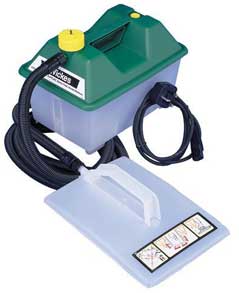There are several ways to strip wallpaper, but the fastest way by far is to use a Wallpaper Steamer or Steam Stripper. These can be bought or hired and should come with all the attachments you need so the only thing you need to add is the water. Using a wallpaper steamer is a good idea if you know that high strength paste was used when the wallpaper was hung.
Using a Wallpaper Steamer Safely
As you will basically be applying water to the wall, and there are probably going to be light switches and sockets on the wall, you need to think about safety. Consider cutting a square of plastic from a carrier bag and taping it over sockets and switches before you start. Make sure you switch off the power at the consumer unit if working anywhere near electrical fixtures with steam or water.
Preparing The Steamer and Room
Make the room ready as you normally would for any decorating task. Put dust sheets down and wear old clothing. It is also a good idea to have some old rubber gloves to wear whilst using the stripper. You will be creating a lot of steam and therefore condensation could be a problem. Always work with a window open if possible and remove any delicate fabrics from the room.
Fill the tank on the stripper to the indicated level, switch it on and wait for the Ready light to come on. Whilst you are waiting, use a paper scoring tool to score the surface of the paper on one wall of the room. Paper scoring tools sometimes come with the steam stripper, but if not they can be bought cheaply from most DIY stores. Scoring the paper allows the steam to more easily penetrate behind it.
Steaming the First Strip
 When the steam stripper is ready to go, choose a sheet of wallpaper to start with and, with your left hand, hold the steam plate of the stripper flat against the paper at the bottom right corner. Hold the plate in place for about a minute or until signs of damp start to show around the edge of the plate. Move the plate across to the next dry area of paper with your left hand and use a paper knife in your right hand to strip the steamed paper you have just revealed.
When the steam stripper is ready to go, choose a sheet of wallpaper to start with and, with your left hand, hold the steam plate of the stripper flat against the paper at the bottom right corner. Hold the plate in place for about a minute or until signs of damp start to show around the edge of the plate. Move the plate across to the next dry area of paper with your left hand and use a paper knife in your right hand to strip the steamed paper you have just revealed.
Work your way across one sheet of wallpaper in this way and then move up to the next dry area and work your way across the sheet again. In no time at all you should be able to work your way up a full sheet and strip it away from the wall. If you encounter any particularly tough areas, simply hold the steam plate over that area for a bit longer before trying to strip with the paper knife.
When the steam stripper starts to run low on water, turn it off for a minute before filling the tank back up with cold water. Turn it on and let it heat the water up again before you continue.
If the paper is stuck directly to plasterboard rather than a plaster skin, you will need to be a bit more careful with the stripper and especially with the paper knife. Keep the knife as flat as possible and try not to let the corners dig into the surface.
Using a Wallpaper Steamer on the Ceiling
You can use a wallpaper steamer to remove wallpaper that has been applied to a ceiling. Follow the instructions as above: Scoring the paper first and then holding the steam plate in place for a few minutes, moving the plate along and stripping the paper with your free hand.
Because you will be working above your head, you need to consider your safety a little bit more than when working on walls. Hot water can drip from the steam plate when it is held above you, so you need to think about protecting your face and arms from being burnt. Wear a hat and goggles, and wear a long-sleeved shirt (or preferably, overalls) to protect your arms. You also need to ensure that the platform you are using to reach the ceiling is stable and safe.
Removing Artex with a Steamer
It is possible to remove Artex from a ceiling using a standard wallpaper steamer. You need to hold the steam plate in one location for longer, to allow the artex to soften, and then scrape the soft coating off the ceiling. This is, however, a very messy and time-consuming job, and it is easier to skim over the artex with plaster.






